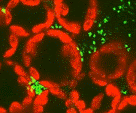Plant Pathology, Department of

Department of Plant Pathology: Faculty Publications
Document Type
Article
Date of this Version
1983
Citation
New Phytol. (1983) 93, 67-76
Abstract
Roots and soils from western Nebraska fields of native and planted grasslands, and winter wheat of varied fallow-wheat cultivation duration, were evaluated for vesicular-arbuscular (VA) mycorrhizal root infection and spore numbers and types. Increased cultivation decreased percentage mycorrhizal infection in wheat and reduced spore numbers of Glomus fasciculatus, the dominant VA mycorrhizal fungus in these soils. Spore numbers of other VA mycorrhizal fungi did not change significantly with cultivation although mean numbers of G. mosseae increased with continued wheat production. Water relations and growth were determined for greenhouse-grown non-mycorrhizal, G. fasciculatus-infected, and G. mosseae-infected wheat in wet and dry soils. Stomatal conductances were higher in mycorrhizal than in non-mycorrhizal plants in both wet and dry treatments. Stomatal closure in mycorrhizal plants occurred at lower leaf water potentials (ψ1) and after greater desiccation than in non-mycorrhizal plants, but some leaves of G. masseae-infected plants showed no stomatal response to drought and continued to transpire at ψ1 as low as -4◦1 MPa. Leaf osmotic adjustment was greater for G. fasciculatus-infected plants. Non-mycorrhizal and G. fasciculatus-infected plants had equal dry wts in both wet and dry conditions. Infection by G. fasciculatus appeared to increase wheat drought tolerance while infection by G. mosseae did not.


Comments
Copyright 1983 The New Phytologist